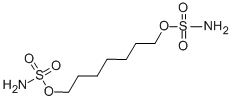96892-57-8
 96892-57-8 結(jié)構(gòu)式
96892-57-8 結(jié)構(gòu)式
基本信息
NCI 329680
NSC-329680
ZINC01574758
7-sulfamoyloxyheptyl sulfamate
Sulfamic acid, S,S'-1,7-heptanediyl ester
Bissulfamideoic acid 1,7-heptanediyl ester
Bis(amidosulfuric acid)1,7-heptanediyl ester
物理化學(xué)性質(zhì)
常見問題列表
IC50: 0.91 μg/mL (Tumors)
At a concentration of 1.0 μg/mL, hepsulfam is active in eight of 37 tumors (22%) in the clonogenic assay. Hepsulfam demonstrates a clear in vitro toxicity to human bone marrow cells (CFU-GM) from healthy donors. Evaluation of equitoxic concentrations in vitro reveals a higher activity of hepsulfam, especially in non-small cell lung cancer. Hepsulfam is more toxic to L1210 leukemia cells than is busulfan, its structural homologue . Consistent with the difference in toxicity, hepsulfam induces DNA interstrand cross-links in L1210 mouse leukemia cells, whereas busulfan does not. Hepsulfam is more cytotoxic to two human leukemia cell lines (111-60 and K562) and to two human colon carcinoma cell lines (BE and HT-29) than is busulfan. As in 11210 cells, hepsulfam induces a higher level of DNA interstrand cross-links than busulfan. Hepsulfam is also more cytotoxic to the human leukemia cell lines when the concentrations are reduced 10-fold and the duration of drug exposure is increased to 12 h.
Hepsulfam demonstrates superior in vivo activity in a large cell lung cancer xenograft and a gastric carcinoma model. The preclinical activity of hepsulfam suggests a possible role of this compound in the treatment of solid human malignancies. However, the increased bone marrow toxicity of hepsulfam as compared with busulfan might be critical for further clinical application.